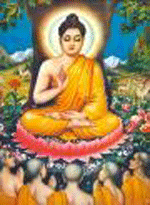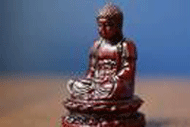Suffering
The countless kinds of suffering can be divided into three:
1.Suffering caused by suffering
This type of suffering includes the pain, sadness and everyday suffering recognized by all beings. Even the smallest insect can recognize it. No creatures want this suffering. The reason why all creatures are so busy and active is that they are trying to avoid this type of suffering. Ants, for instance, are busy all day and night to avoid suffering from hunger; countries fight each other for fear of suffering from domination (even though this method creates more suffering).
2.Suffering caused by change
This type starts as happiness and then changes into suffering. Most beings do not recognize this as suffering. Worldly happiness looks like happiness, but in time it too changes into suffering. If we are hot and immerse ourselves in cold water it is very pleasant to start with, but after a while it becomes painfully cold. If we are cold and stay in the sun to get warm we will, after some time, suffer from being burnt. When friends meet after a long time they are delighted, but if they then remain continually together they may quarrel and grow tired of each other.
 This type of suffering includes anything that appears to be happiness and changes into suffering. If a person wants to become wealthy, works very hard and becomes rich, suffering is produced from the need for maintaining the wealth, fear of losing it, and desire for more. If one country wants to take over another, the oppressed country reacts, and mutual suffering is caused.
This type of suffering includes anything that appears to be happiness and changes into suffering. If a person wants to become wealthy, works very hard and becomes rich, suffering is produced from the need for maintaining the wealth, fear of losing it, and desire for more. If one country wants to take over another, the oppressed country reacts, and mutual suffering is caused.
The first of these two types of suffering is easily removable. The second is not, because it is not easily recognized. Thus, it is more deeply harmful. Even small insects can stop the suffering caused by suffering, and so can human beings, who, when they are ill, for example, can get treatment. But most people and animals think that the suffering caused by change is real happiness and spend their whole lives trying to achieve it; for example, people in business who devote their lives to making money and people who fight each other in wars, all in search of happiness.
3. All-embracing suffering caused by mental formations
This type is even more difficult to recognize than the suffering caused by change. It is the suffering inherent in samsara (the whole round of existence) and the cause of the previous two kinds of suffering. It covers, or embraces, all beings in samsara. As the earth is the foundation of our life, so this type of suffering is the foundation of the other two. If someone cuts us we automatically feel pain simply because we have bodies; our very existence is the root cause of this suffering.
Because all beings exist in a state of causality, all are liable to suffering. This kind of suffering (duhkha) is produced from a harmful cause and all other suffering comes from it. All beings recognize the first kind of suffering; some recognize the second. But this third kind of suffering is very, very difficult to recognize. Without recognizing it, escape from samsara is impossible. This suffering is like a wound that does not give pain until it is touched. It is the ground containing all sufferings. When we remove this suffering we attain nirvana, or liberation.
To practise Dharma, understanding suffering is the first essential. Without this understanding, the will to get out of suffering does not arise. We are like people in prison who don’t recognize where we are or how bad it is, and therefore have no wish to escape. If we are ill but do not recognize it, we have no wish to be cured.
If the first type of suffering is not recognized we can have no wish to escape from suffering. If the second is not recognized we will try to escape from it in the wrong way, only to return to suffering again. If the third type is not recognized, then even if our method is good, we cannot get to the root of all suffering.
Therefore, it is very important to recognize all three kinds of suffering. This recognition is the first door to practising Dharma and also the reason for practising. This is the reason that the Buddha taught suffering as the first noble truth. We can observe suffering directly by looking around us. The suffering caused by suffering is evident in everybody. The suffering caused by change, unreal happiness, is also quite obvious. We can see also that all other sufferings derive from the all-embracing suffering caused by mental formations. Although it is difficult to know what causes these sufferings, we must experience them and see them for what they are; from our experience our belief will be strong and steady. That is why the Buddha said it was important to judge and test his teachings for ourselves, giving the example of assaying gold. When we see that reality is as the Buddha said, our faith in the Buddha will be strong and not be destroyed by what others tell us.
All suffering has a beginning and an end. Things are undergoing change all the time. There are two types of change: coarse, obvious change—as when a table is being made and the changes are plain—and subtle change, such as the molecular changes going on continually inside the table.
The changes in human life are obvious—people start small, grow larger, and age. But it is not so obvious that in the time it takes to snap your fingers everything has changed. If you pour water from a pot, the stream appears to be one unit, but in fact, at each moment, the stream has moved and become something else.
Not only sentient beings but also the whole environment—trees and so on—are undergoing change. All beings in samsara are suffering all the time. If we do not recognize suffering fully we will not practise what is necessary to get out of it.
The Cause of Suffering
 All suffering has a cause. If the cause is not removed, escape from suffering is impossible. If rain is coming in through a hole in the roof, there is no use sweeping the water out of the house without blocking the hole as well. If we are sick and take medicine for the symptoms alone, we may be able to stop them for a time, but we cannot be sure they will not recur. If, however, we eradicate the cause of suffering we can prevent its recurrence forever.
All suffering has a cause. If the cause is not removed, escape from suffering is impossible. If rain is coming in through a hole in the roof, there is no use sweeping the water out of the house without blocking the hole as well. If we are sick and take medicine for the symptoms alone, we may be able to stop them for a time, but we cannot be sure they will not recur. If, however, we eradicate the cause of suffering we can prevent its recurrence forever.
Although we can do nothing about the suffering of the past, we must close the door of future suffering. If a thorn tree outside our house pricks us every time we pass, it is no real solution to cut off odd branches; we must uproot the tree completely. We need to find the real cause, not an illusory one. If we make a mistake about the cause of suffering, real progress will be impossible. So we must know the second noble truth, the cause of suffering.
The cause of suffering has two divisions: karma (action) and klesha (mental defilements).
At this time we are experiencing much suffering, whose cause we ourselves created in past existences. Therefore we ourselves have to do the work to escape from it. A teaching about the cause of and escape from suffering is useless if we do not practise it. If we are sick and go to the doctor, who gives treatment, we must follow the doctor’s instructions in order to be cured. In school a student needs the teacher’s instruction, but the most important thing is the student’s own work. Up to now we have never practised the path, so we are still in samsara. Those beings who have practised it, such as Milarepa, have passed out of samsara. This passing was not easy. Milarepa’s buttocks were covered in sores from sitting for so long in meditation. When Lorepa was meditating in the mountains, no-one brought him food, so he lived by gradually eating his shoes. Lama Tsongkhapa meditated in the high mountains, always offering mandalas on a stone slab. The skin on his right forearm was rubbed away from polishing the stone. Escape from samsara depends on ourselves alone; if it depended on only the Buddha, there would be no one in samsara, because that was his great wish. As a good mother loves her children, he has equal love for all beings. In one sutra the Buddha taught:
The Buddha cannot wash away the delusion of beings with holy water;
Neither can he take away the suffering of beings with his hand.
He can not give wisdom to beings if they do not practise. The Buddha’s responsibility is to show the true path. In another sutra it says:
I am my own lord and my own enemy.
” Lord” because if we practise Dharma, we can look after ourselves and bring ourselves much happiness; “enemy” because if we do not practise properly, we build up more and more suffering for ourselves.
The Buddha teaches the way; we practise it. This combination brings happiness.




